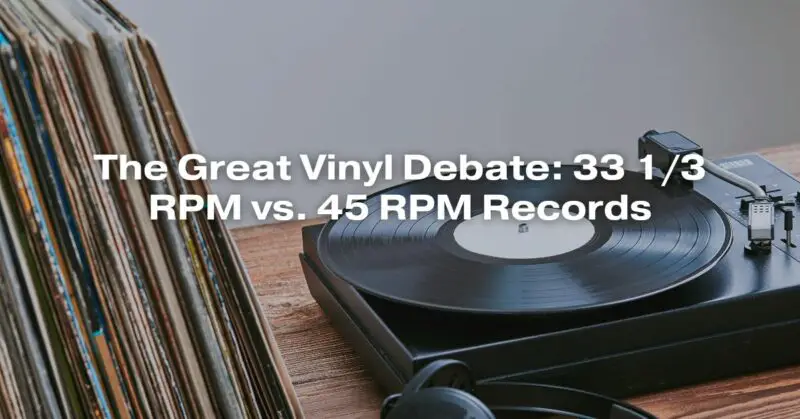Vinyl records have seen a remarkable resurgence in popularity in recent years, with music enthusiasts and audiophiles rediscovering the warmth and authenticity of analog sound. However, within the vinyl community, a spirited debate has been ongoing for decades: 33 1/3 RPM (revolutions per minute) vs. 45 RPM records. Each speed has its own unique characteristics, advantages, and disadvantages, making this a fascinating subject for those passionate about the vinyl experience. In this comprehensive article, we will delve into the key differences between these two vinyl record speeds, their history, and why vinyl enthusiasts continue to embrace both.
A Historical Perspective
Before diving into the technical aspects, it’s essential to understand the historical context of these two record speeds. The 33 1/3 RPM record, often referred to as the “LP” (Long Play), was introduced by Columbia Records in 1948. This innovation allowed for longer playing times, with up to 22 minutes of music per side. It quickly became the standard for full-length albums, revolutionizing the way music was consumed.
On the other hand, the 45 RPM record, also known as the “single” or “7-inch,” was introduced by RCA Victor in 1949. While it had a shorter playtime of around 3-5 minutes per side, it became the format of choice for single songs and jukeboxes. Its higher rotational speed allowed for better sound quality in the limited playing time.
Sound Quality
One of the most significant factors that influence the vinyl debate is sound quality. The speed at which a record spins directly impacts the quality of the audio it produces.
33 1/3 RPM Records:
- Richness and Detail: Records spinning at 33 1/3 RPM generally offer a deeper, more detailed sound. With more grooves per inch, there’s room for greater fidelity, especially in the midrange and low frequencies.
- Extended Playing Time: The slower speed allows for longer playing times per side, making it suitable for full albums. This extended duration is why LPs are the preferred format for albums.
- Less Surface Noise: Due to the larger groove size and slower rotation, surface noise is typically less pronounced on 33 1/3 RPM records, provided they are in good condition and well-maintained.
45 RPM Records:
- High-Frequency Clarity: 45 RPM records excel in reproducing high-frequency details. The faster rotation allows for more precise tracking of high-frequency information, resulting in clearer vocals and instrumentals.
- Dynamic Range: With less music squeezed into each rotation, 45 RPM records often have a broader dynamic range, making them ideal for audiophiles who seek to hear every nuance in the music.
- Quick Listening Experience: 45s offer a quick and convenient way to enjoy a single song. They were popular for jukeboxes and continue to be favored for DJs and collectors of hit singles.
Collector’s Perspective
From a collector’s standpoint, both 33 1/3 RPM and 45 RPM records have their unique appeal:
33 1/3 RPM Records:
- Album Art and Packaging: LPs often feature larger album artwork and extensive liner notes, making them prized collectibles for enthusiasts who appreciate the visual and textual aspects of music.
- Full Albums: Collectors of 33 1/3 RPM records are drawn to the immersive experience of listening to complete albums, as artists intended.
45 RPM Records:
- Singles and Rarity: Collecting 45s can be exciting due to the hunt for rare and valuable singles. Many iconic songs were released exclusively on 45 RPM records.
- Limited Editions: Limited-edition 45 RPM releases, often in colored vinyl, picture discs, or special packaging, are highly sought after by collectors.
The Vinyl Revival
The vinyl revival of the 21st century has seen a resurgence of interest in both 33 1/3 RPM and 45 RPM records. Audiophiles and music lovers alike appreciate the tactile experience of handling vinyl and the unique sonic characteristics of each format.
Additionally, modern advancements in vinyl manufacturing have improved the overall quality of records, regardless of their speed. High-quality pressings, superior mastering techniques, and audiophile-grade turntables and cartridges have elevated the vinyl listening experience, allowing enthusiasts to enjoy the best of both worlds.
In Conclusion
The Great Vinyl Debate of 33 1/3 RPM vs. 45 RPM records is not about one format being superior to the other; rather, it’s a celebration of the diverse and rich tapestry of the vinyl medium. Both speeds have their unique strengths and serve different purposes within the world of music.
Ultimately, the choice between 33 1/3 RPM and 45 RPM records comes down to personal preference, musical taste, and the listening experience you seek. Some listeners prefer the immersive journey of an entire album at 33 1/3 RPM, while others relish the clarity and immediacy of a single song at 45 RPM. Regardless of your choice, what’s clear is that vinyl records continue to captivate music enthusiasts, ensuring their place in the world of audio for generations to come.

